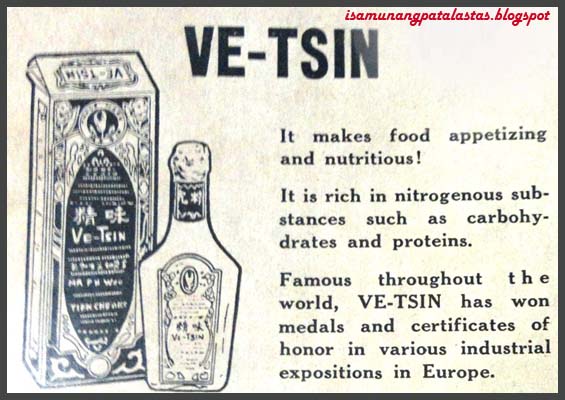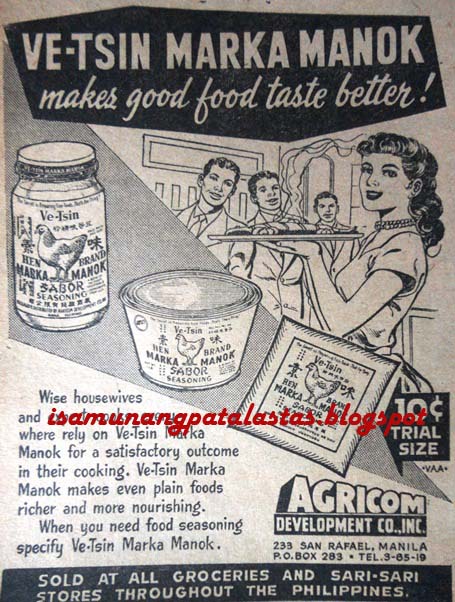Just the mention
of iconic brand names like COLGATE, PALMOLIVE, or PUREFOODS instantly conjure
images of the products they represent: Toothpaste, Shampoo, Meat Products,
respectively. But at one point in their brand history, the names were also
applied by their companies to other products, now long gone. Here are some of
them.
**********
1. COLGATE SOAP
(1956)
Since its launch as a toothpaste brand in 1873, COLGATE
has, at one point, become a generic name for toothpaste. It was the first to be
packaged in tubes in 1896. Colgate is associated with oral hygiene with products
like mouthwashes, toothbrushes, and dental floss. COLGATE Toothpaste was
introduced in the Philippines in 1926 by the Palmolive Co, Philippines, which,
in 1949, became Colgate-Palmolive Philippines.
Palmolive was known for its soap, so this is probably the reason that in
1956, COLGATE SOAP was introduced to the Philippine market. The idea didn’t
catch on—maybe it conjured images of brushing your mouth with soap!
2. HUNT’S FRUIT
COCKTAIL (1957)
HUNT’S is an iconic brand name, founded ay back in 1888
in California. It is well-known as a maker of preserved tomato products like
sauce, paste, expanding into tomato-based pork and beans—which has become
synonymous with the name. HUNT’S Pork and Beans is known by almost every
Filipino in the 1950s as it was a staple “emergency” canned product. Not very
many know that there was also a HUNT’S FRUIT COCKTAIL introduced in the
Philippine in 1957. That’s because the original company, Hunt Bros. Fruit
Packing Co.,(founded by Joseph and William Hunt) also canned fruits and
vegetables, a business which boomed in California. The product did not really
do well locally.
3. LADY’S CHOICE
VIENNA SAUSAGE (1965)
California Manufacturing Company (CMC) was established in
1955, and immediately became well-known for its line of spreads that included
jams and mayonnaise. LADY’S CHOICE was one of the company’s early brand
successes in the Spreads Market. The first products were LADY’S CHOICE Jelly,
Preserves, Mayonnaise, and by 1965, the line had expanded to include other food
products like macaroni, spaghetti, and of all products—LADY’S CHOICE VIENNA
SAUSAGE! Eventually, the canned sausages were phased out after CMC realized
that the spreads (Mayonaisse, Salad Dressing, Sandwich Spread) were the Lady’s
Choice brands that were bringing in the money. Unilever bought the company,
along with Bestfoods in 2000.
4. PALMOLIVE POMADE
(1955)
The world was introduced to PALMOLIVE in 1898, when the
B. J. Johnson Soap Co., gave us a soap bar made of palm an olive oil, hence the
brand name that endures to this day. PALMOLIVE Soap was known to Filipinos in
the late 1920s when it was distributed in the Philippines by Palmolive Co. Phils.
The soap brand even became more familiar after the merger with Colgate, and the
PALMOLIVE line was soon extended to include talcum powder, shampoo, and male-oriented
products. In the mid 1950s, the company launched PALMOLIVE POMADE—“the pomade
for successful men”. There was also, briefly a PALMOLIVE Skin and Hair Tonic, produced at the same
time. Apparently, the brilliantine pomade and tonic did not last long, but
PALMOLIVE as a soap and shampoo brand proved to be more enduring.
5. POND’S LIPS LIPSTICK
(1960)
POND’S, has a rich, 150 year history as the maker of POND’S
Cold Cream, the world’s first
moisturizer that does not require refrigeration, and POND’S Vanishing Cream,
which made women’s skin soft, supple and dewy. In 1846, American pharmacist
Theron Pond developed the Pond’s Extract, with a unique tea extract from witch
hazel that helped restore skin damage below the surface. The face creams were
introduced to the country when the POND’S Company merged in 1955 with the
Chesebrough Manufacturing Co., which already had an extensive line-up of facial
care products. By the 60s, POND’S was an established brand of cosmetic beauty
products. An effort to extend the line to include make up products was
attempted in 1960 with the launch of POND’S LIPS—lipsticks “for irresistible
lips”. But Filipinas resisted the idea,
preferring the facial cream more instead, so POND’S LIPS was discontinued.
6. PRESTO COFFEE
(1962)
The taipan George Gokongwei founded the Consolidated Food
Corporation in 1961. It is best known for producing Blend 45 that gave Nescafe
and Café Puro a run for their money. Next, CFC launched its chocolate products,
so the PRESTO brand. With treats like Nips, Manor House, Milky Bar, Apollo
Chocolate Bars and Wafrets, PRESTO came to be associated with chocolates. There
was even a PRESTO Cocoa and PRESTO Chocolate Drink. But PRESTO did not start as
a name for chocolates—but as a coffee brand. In 1962, PRESTO COFFEE was
launched by CFC as a complement to Blend 45. PRESTO COFFEE was retired when CFC
decided to single-mindedly build the Blend 45 brand which was enjoying
tremendous market success, and make it
their flagship brand. PRESTO later was used as a name for CFC’s ice cream
brand, and today, it is acookie brand of Universal Robina Corp. (URC).
7. PURE FOODS JAM
(1965)
Founded in 1956, PURE FOODS was put up in Mandaluyong by
a group of enterpreneurs which first produced hams, bacons and hot dog sausages. It is in the manufacture of quality meat
products that PURE FOODS built its name. Over the years, however, it forayed
into other food products—making catsup, chili con carne, bottled pickles—and in
1965, the company put out PURE FOODS JAMS. The bottled spreads included Mango,
Pineapple, Guava, and Mango-Pineapple. Eventually, PURE FOODS stuck to making products
it knew best, and today, it is the leading maker of quality meat products in
the country.




















































